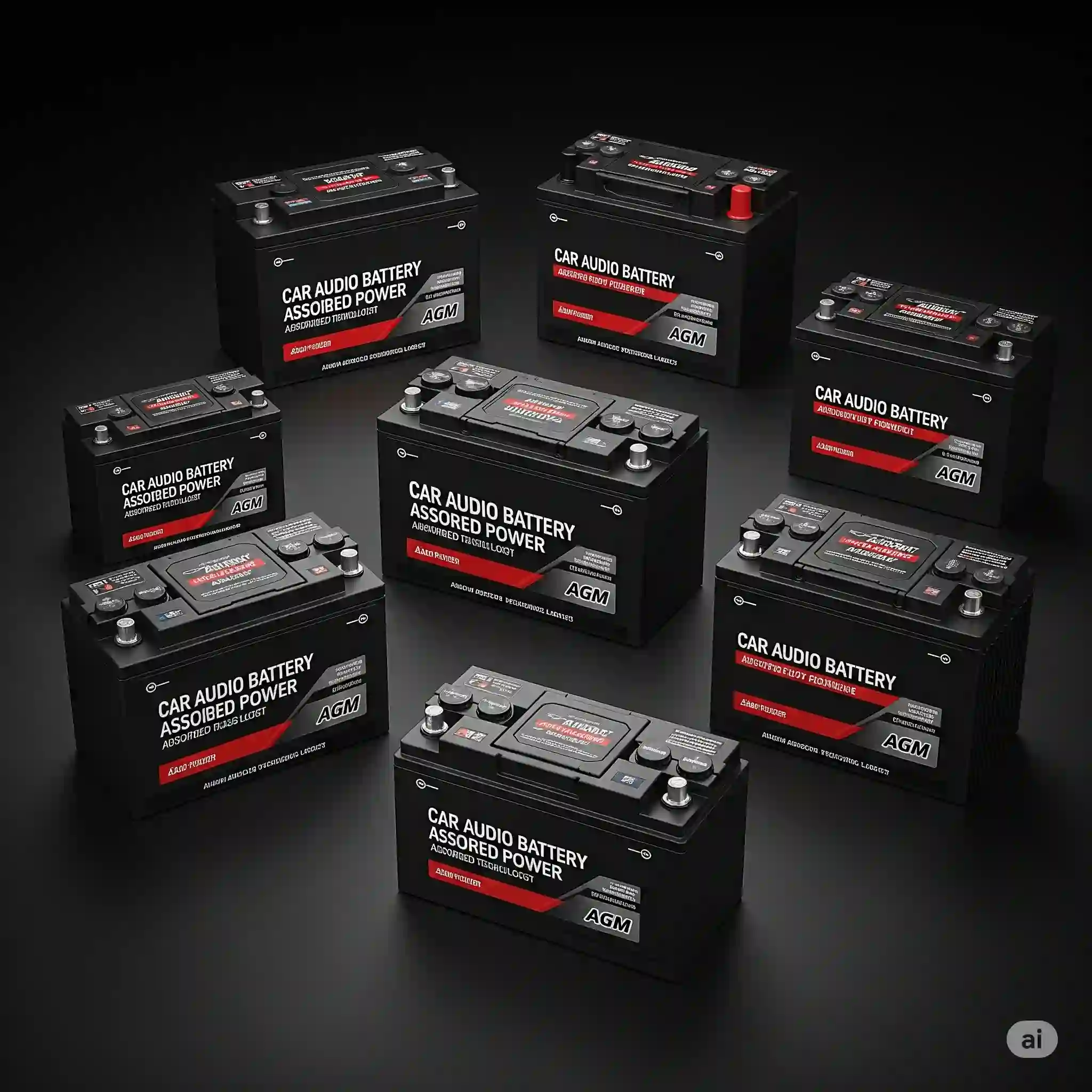There was a time I sat in my car after a demo, bass still ringing in my ears—and the engine wouldn’t start. My amps had drained the battery dry. That moment taught me something most beginners overlook: regular car batteries just don’t cut it when you’re running a serious sound system. Over the years, I’ve tested everything from basic AGM setups to full-blown lithium car audio batteries, and I’ve made plenty of mistakes so you don’t have to. In this article, I’ll walk you through what I’ve learned about car audio batteries—from choosing the right one for your subwoofer setup to avoiding voltage drops that kill your vibe mid-song. Let’s make sure your next bass drop doesn’t leave you stranded.
Why You Need a Dedicated Car Audio Battery
When I first got into car audio, I thought the stock battery under my hood was enough. After all, it powered the car, right? But once I added a real system—amps, subwoofers, and some solid midbacks—that battery just couldn’t keep up. It wasn’t long before the music would cut out, the lights dimmed with every beat, and my voltage gauge looked like it was begging for mercy. That’s when I learned: if you’re serious about your sound, a dedicated car audio battery isn’t optional—it’s essential.
Whether you’re running a mild setup or chasing SPL numbers, having a reliable power source makes the difference between smooth, clean sound and frustrating cutouts. Let’s break down why.
What Makes Car Audio Systems So Power-Hungry?
Think of your sound system like a gym rat hitting the bench press—it needs short, heavy bursts of energy to perform at its best. Every time the bass hits, your amplifier pulls serious current from the battery. That power draw spikes, sometimes reaching 100–300 amps depending on your setup.
This heavy load causes your voltage to drop, especially if your battery can’t recover fast enough. And when voltage drops, sound quality suffers—amps can clip, subwoofers distort, and everything starts to feel unstable. I’ve been there: cruising down the road, volume halfway up, and suddenly the bass softens, mids start fluttering, and I’m glancing at my voltmeter in panic.
A good car audio battery acts like a buffer. It stores energy and delivers it fast when your system needs it—keeping voltage steady and performance strong, even when you’re pushing your gear to the limit.
Why Your Stock Car Battery Isn’t Enough
Stock car batteries were never designed for continuous deep power demands. They’re great at starting your engine and powering your headlights, but not at feeding 2,000+ watts of clean current to an audio setup. And when they fall behind, your alternator tries to cover the slack—which only leads to more stress on your vehicle’s electrical system.
I remember doing a demo once where my midst cut out halfway through a track. The culprit? My voltage had dipped under 11.8V, and the amp’s protection kicked in. That one moment pushed me to install a dedicated battery in the rear, and it changed everything. No more clipping. No more lights dimming. Just smooth, clean sound—even at high volume.
A battery for your car stereo or sound system adds stability and reliability—especially when paired with a properly matched alternator. It protects your gear, keeps your performance consistent, and makes sure you’re not left stranded when your system steals more power than your car can spare.
Types of Car Audio Batteries Explained
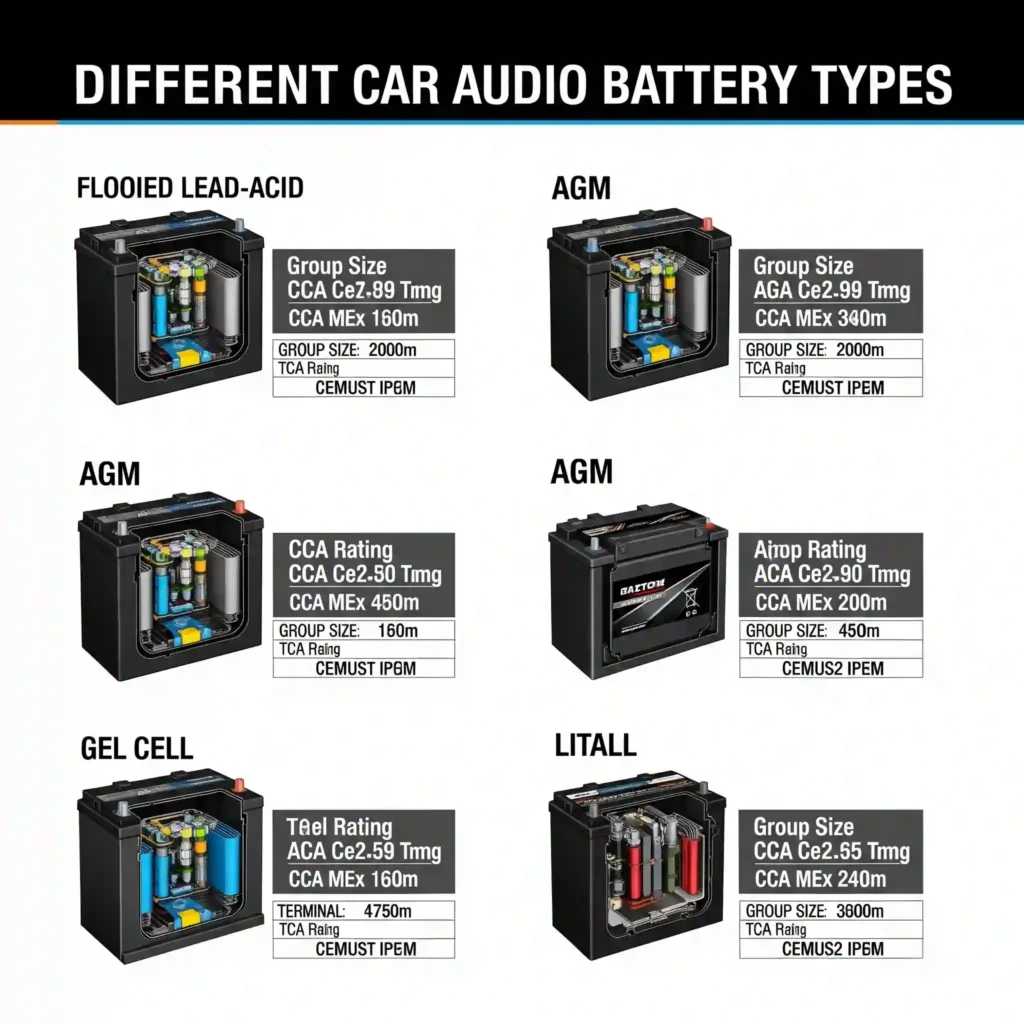
If you’re new to car audio batteries, it’s easy to get overwhelmed by the different types out there. I’ve been down that rabbit hole myself—reading forums, watching test videos, and asking way too many questions at meets. But once you understand the basics, it’s not that complicated. There are two main types of batteries you’ll come across in car audio: AGM (Absorbent Glass Mat) and lithium, which includes LTO and LiFePO4. Each has its place, depending on your goals, budget, and power needs.
AGM (Absorbent Glass Mat) Batteries

If you’re just getting started or building a mild system, AGM batteries are usually the first stop. They’ve been around for years and are built tough. Think of them as the dependable workhorses of car audio—not flashy, but solid and reliable.
AGM batteries are sealed, spill-proof, and safe to install in almost any orientation. They’re budget-friendly, easy to find at your local shop or online, and they play nice with your stock alternator. I’ve used them in multiple daily drivers and had good results—especially for systems under 2,000 watts RMS.
But here’s the trade-off: AGM batteries are heavy and take longer to recharge. They also drop voltage faster under load, which can lead to dimming lights or amp clipping when the bass hits hard. Still, for daily listening or mild upgrades, they get the job done without breaking the bank.
A good example is the Skar Audio SK-BATT20AH or 35AH. They’re affordable, compact, and work well as a secondary battery if you’re not ready to go lithium just yet.
Short Answer: AGM batteries are great for entry-level to mid-tier car audio setups—they’re safe, affordable, and easy to install.
Lithium Car Audio Batteries (LTO & LiFePO4)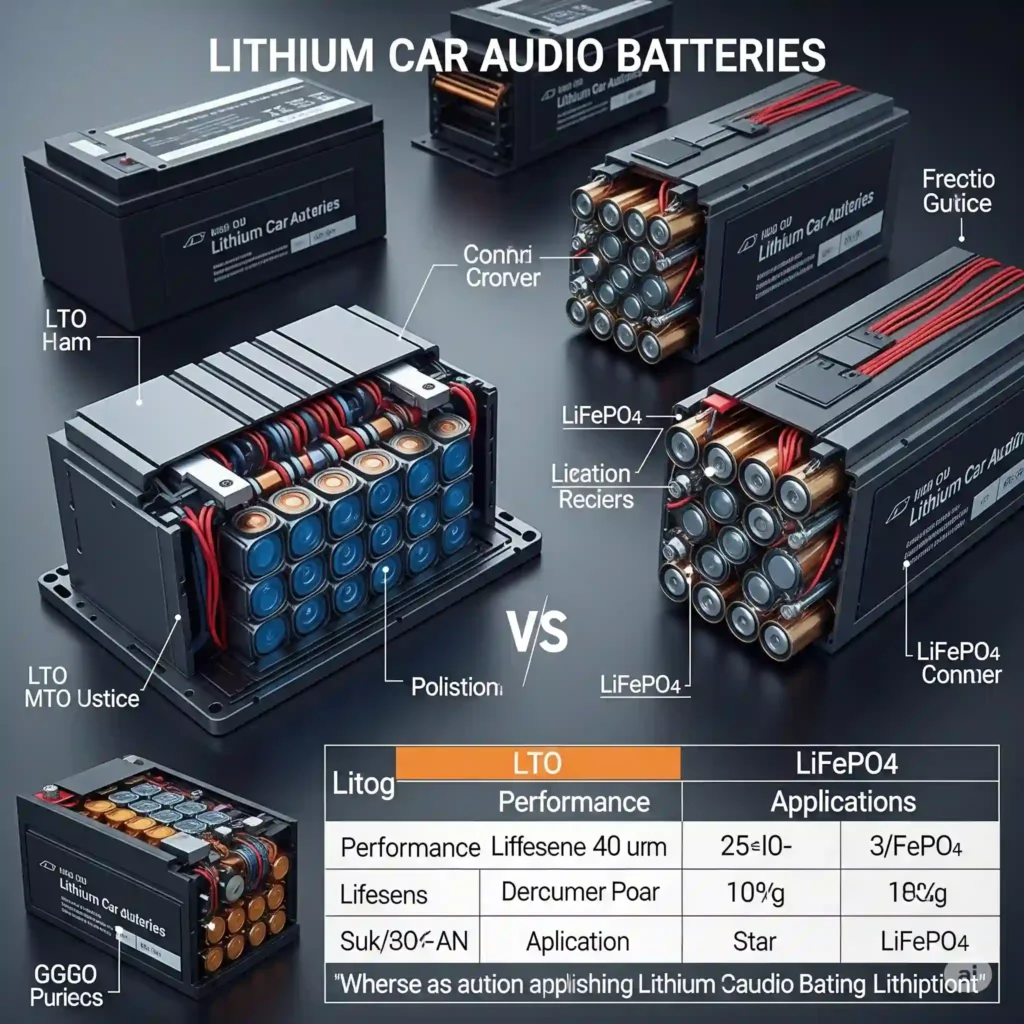
Now, if you’re chasing big numbers, deep bass, or clean power with minimal voltage drop, lithium batteries are where it’s at. These things charge faster, hold voltage better, and weigh a fraction of what AGMs do. After switching to lithium, I was honestly shocked at how clean and punchy my system sounded—even with the volume cranked.
There are two main types of lithium batteries in the car audio world: LTO (Lithium Titanate Oxide) and LiFePO4 (Lithium Iron Phosphate). Both are good, but LTO tends to handle high current draw better, which is why many SPL guys swear by them. The only downside? They’re pricey—and they need a charging setup that matches their voltage range.
For reference, I tested both the Titan8 Reserve and Power Series in my build. The Reserve gave me great runtime and handled daily use like a champ. But when I dropped in the Power Series, the difference was immediate—faster response, stronger bass, and less voltage sag. Even with the car off, it held power like a beast during SPL testing.
One thing to remember: lithium isn’t plug-and-play. You need to make sure your alternator, voltage settings, and wiring are all dialed in. But if you want serious performance, it’s more than worth the extra effort.
Short Answer: Lithium car audio batteries deliver top-tier performance—faster charging, better voltage stability, and lighter weight, perfect for high-wattage systems.
Best Car Audio Battery for Your Setup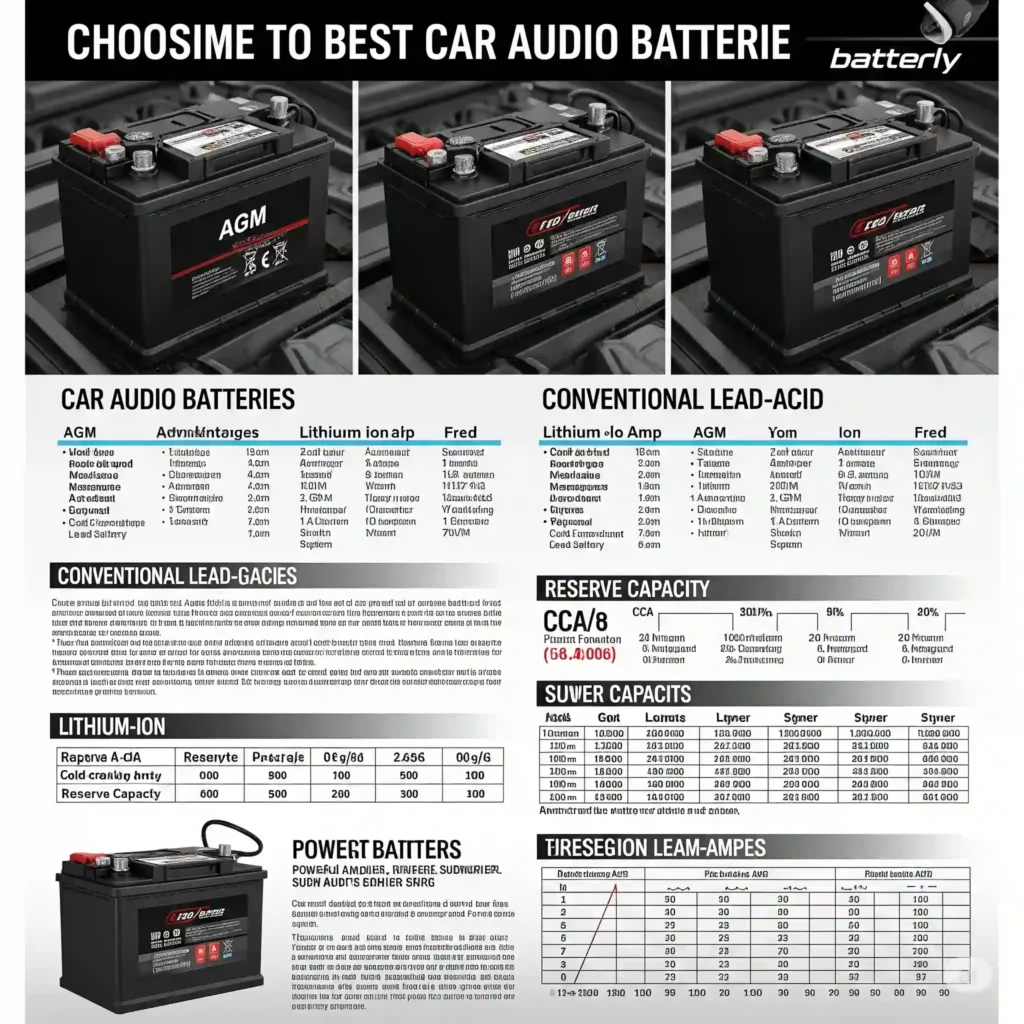
When it comes to picking the right car audio battery, it’s not just about grabbing the biggest one you can afford. Trust me, I’ve made that mistake before. Your setup’s power needs, space, and budget all play a role. Whether you’re running a simple amp and sub or a wall of woofers, the goal is the same: clean, reliable power with no lights dimming or amps clipping.
Short Answer: The best car audio battery depends on your system’s wattage, your alternator’s output, and whether you’re daily driving or chasing SPL scores.
Light to Moderate Systems (Under 1500W RMS)
If you’ve got a clean daily setup—maybe a 500W mono block pushing a sub under the seat or a pair of 12s in the trunk—an AGM battery is usually more than enough. These systems don’t pull insane current, and if your stock alternator is in good shape, you likely won’t need anything crazy.
I’ve used the Skar SK-BATT20AH and SK-BATT35AH in this range with great results. They’re compact, easy to mount, and provide just enough reserve capacity to smooth out voltage dips when the bass hits. For a clean daily driver, it’s a solid upgrade.
Short Answer: For under 1500W RMS, a quality AGM car audio battery like Skar’s 20AH or 35AH will cover your needs without overkill.
Mid-Range Systems (1500W–3000W RMS)
This is where things start getting real. When your subwoofer battery has to keep up with 2,000+ watts of bass, a single battery usually isn’t enough—especially if you’re still using the stock front battery. In my case, my lights started flickering, and I noticed some distortion at higher volumes. That’s when I learned the value of a secondary battery.
For these builds, I recommend pairing an AGM up front with either another AGM or a lithium battery in the rear. It helps balance the load and keeps voltage steady. If you’re not ready to go full lithium, a dual-AGM setup is still effective and much easier to wire.
Short Answer: For 1500–3000W RMS, run a secondary battery—either dual AGM or a mix of AGM and lithium—for balanced power delivery.
Heavy-Duty Systems (3000W+ RMS)
If you’re running a wall of subs, competing in SPL, or just like to feel your chest rattle with every drop, there’s no getting around it—you need lithium. AGM simply can’t keep up with this kind of load. I’ve tested setups above 4,000 watts RMS, and AGM couldn’t hold voltage above 12.0V for more than a few seconds at full tilt.
This is where batteries like the Titan8 Power Series, Excess Power, or even DIY Yinlong banks come into play. They handle current draw like champs, recharge fast, and stay cool under pressure. In my SPL test build, switching to lithium shaved almost a full volt of drop during tone sweeps—and that translated directly into louder, cleaner bass.
Short Answer: For high-wattage systems above 3000W RMS, lithium car audio batteries are essential for maintaining voltage and hitting peak performance.
Installation Tips for Car Audio Batteries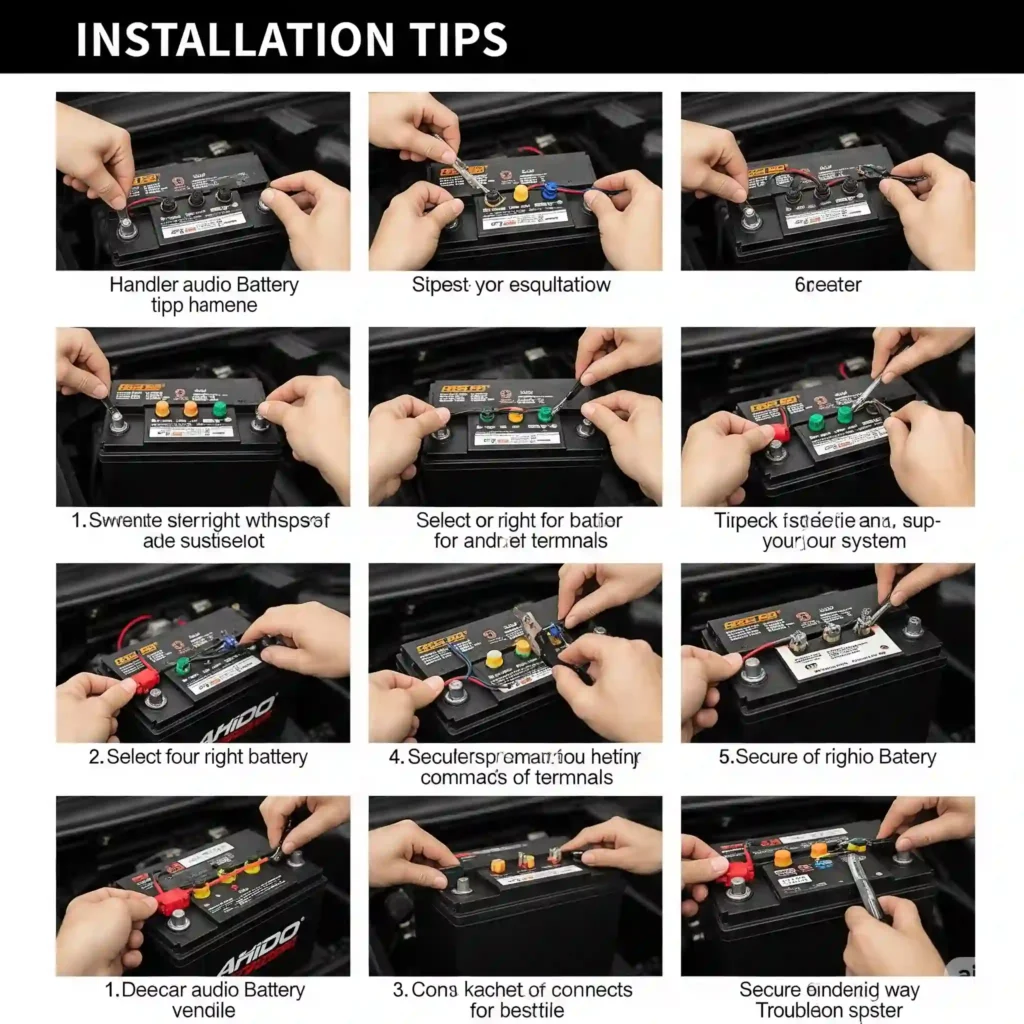
Getting the right car audio battery is only half the battle—the way you install it matters just as much. I’ve seen killer builds fall flat just because the battery was mounted wrong, fused poorly, or wired like a spaghetti mess. A good battery setup should feel like a solid foundation, not a ticking time bomb.
Short Answer: A clean, safe battery install protects your gear, boosts performance, and keeps voltage steady when your system hits hard.
Can You Mix AGM and Lithium?
This is a question I get all the time: can you run an AGM battery up front and lithium in the back? The short answer is yes, but only if their resting voltages match. I’ve personally run a front AGM and a rear lithium (LiFePO4), and it worked—but I had to use a relay and voltmeter to keep things in check.
The key is matching the voltage ranges and isolating them when needed. You don’t want your AGM trying to charge your lithium or vice versa. If you’re not 100% sure, keep it simple and stick with the same type throughout.
Short Answer: You can mix AGM and lithium, but only if their voltages match and the setup is carefully managed.
Where to Install a Secondary Battery
Placement matters more than people think. I’ve mounted batteries in the trunk, under seats, and even in the spare tire well. Each has its pros and cons. The trunk is easiest, but you’ll want short, thick wire to reduce voltage drop. Under the seat works great for compact AGMs, but space is tight. The spare tire well? That’s my favorite—out of the way and close to the amps.
Whatever spot you pick, just make sure it’s secure and ventilated. Batteries don’t like heat or vibration, and you definitely don’t want one rolling around at 70 mph.
Short Answer: Mount your secondary battery close to your amps, in a stable, cool, and secure spot like the trunk or spare tire well.
Wiring and Safety Tips
Now we’re getting into the part people love to skip—and regret later. Always fuse your power wires within 18 inches of the battery, no excuses. I once fried a perfectly good amp because I skipped a fuse “just for a test.” Big mistake. Use the right gauge wire for your wattage—4 AWG is fine for smaller setups, but for anything serious, go 1/0 gauge.
And if you’re running lithium? Respect it. These batteries can dump a ton of current fast. Use quality ring terminals, keep connections tight, and double-check your grounds. One loose wire can turn your clean build into a fire hazard.
Short Answer: Use proper fuses, thick wire, and solid grounds—especially with lithium car audio batteries—to stay safe and perform at your best.
AGM vs Lithium Batteries: Which Should You Choose?
If you’re stuck between AGM and lithium for your car audio setup, I’ve been there too. I remember pacing back and forth in my garage, trying to decide if I should drop more money on lithium or stick with my trusty AGM that had been “good enough” so far. Let me break it down based on what I’ve seen, felt, and tested—so you can make the right call without second-guessing.
Short answer: AGM is great for budget and daily use. Lithium wins on power, speed, and voltage control—especially in bigger builds.
AGM batteries are like that reliable old friend—dependable, sturdy, and always down to help you out. When I first got serious about car audio, AGM was my go-to. Why? Because it was simple, cheap, and didn’t need any fancy charging systems. I could pick one up, bolt it down, and get back to tuning my mids and lows.
But here’s the thing: when the bass hit hard, I started noticing the lights dimming. The amps would clip on heavy drops. My system felt like it was holding back—like it wanted to roar but had no breath left. That’s when I realized AGMs do their job well, but only up to a point.
Short answer: AGM batteries work fine for daily drivers under 2000W RMS but start to struggle when you push them hard.
Then I switched to lithium—and it felt like I’d just installed a turbocharger in my sound system. The bass hit cleaner. The voltage stayed steady, even with everything cranked. It was a whole different level of control and punch. My first test with the Titan8 Power Series blew me away—there was almost zero voltage drop, even at full tilt. And the recharge time? Way faster.
But lithium isn’t plug-and-play. It needs the right alternator, proper wiring, and safe voltage settings. I spent a weekend tweaking and checking everything, from fuse placement to voltage regulators. It takes more effort, but the reward is next-level sound.
Short answer: Lithium batteries deliver stronger performance, faster recharge, and rock-solid voltage—but need proper setup and budget.
Comparison Table:
|
Feature |
AGM Battery |
Lithium Battery (LTO, LiFePO4) |
|
Weight |
Heavy—makes your trunk feel like a gym bag | Super light—you’ll be shocked the first time you lift it |
|
Price |
More affordable upfront | Higher cost, but pays off over time |
| Charge Time | Slower to recharge |
Charges fast—great for daily hits or SPL rounds |
| Voltage Stability | Drops faster when the bass hits |
Holds voltage steady, even under hard pounding |
|
Lifespan |
Shorter—especially under heavy loads | Longer lifespan when properly maintained |
| Best For | Budget builds, daily drivers under 2000W RMS | High-watt systems, demo cars, competition SPL setups |
Short answer: AGM is simple, affordable, and great for beginners. Lithium takes more setup but delivers top-tier performance and long-term reliability.
This table helps summarize everything I’ve learned by actually using these batteries in real systems. Whether you’re just starting out or going all-in on your dream build, you now know what to expect from each option.
What I Use and Recommend (My Personal Setup)
Let me tell you what I’m running right now—and what I’ve tried in the past.
Right now, my daily build runs a Titan8 Power Series lithium battery in the rear and a solid AGM up front. I’ve tested a bunch of setups over the years, but this combo gives me the best of both worlds. The AGM handles start-up duties and regular driving needs. The lithium takes care of the bass—and man, it delivers.
Short answer: I use a mix of AGM and lithium to balance budget, daily use, and max performance.
I used to run dual AGM batteries. Back then, I thought I was all set. But once I upgraded my subwoofers and went above 3000W RMS, things started to change. The amps began clipping. Lights flickered. And that full, clean bass? It started to fade during long sessions. That’s when I knew AGM alone just couldn’t hang with high-power demands.
Swapping in a lithium battery was like adding nitrous to the system. The voltage held strong. My subs hit cleaner. I didn’t even realize how much performance I was missing until I made the switch.
Short answer: When I upgraded from AGM to lithium, the improvement in power and sound quality was instant.
For wiring, I use 1/0 gauge OFC cable throughout the build—nothing cheap or undersized. It’s fused within 18 inches of both batteries and grounded properly. I also run a voltmeter on the dash so I can keep an eye on things. It sounds basic, but watching voltage live has saved me more than once from overheating or cutting out mid-song.
And no, I don’t let lithium run unchecked. I’ve got a smart isolator and a relay system that only lets it connect once the alternator is charging. That setup keeps the batteries safe, avoids backflow issues, and makes everything last longer.
Short answer: I use proper fusing, thick wire, and voltage monitoring to stay safe and squeeze out every bit of performance.
If you’re just getting into car audio, you don’t need to copy my setup exactly. Start with what fits your system and your wallet. A simple AGM in the back might be enough for now. But if you’re pushing 2000W or more, and you want clean, chest-thumping bass with no flickers or dropouts, start looking into lithium.
I’ve made mistakes. Burned through gear. Sat in parking lots with a dead car after a demo. That’s why I recommend what I use—not because it’s trendy, but because it works.
Short answer: My setup works because I learned the hard way—now I balance power, protection, and performance with every part.
 FAQs About Car Audio Batteries
FAQs About Car Audio Batteries
Q: Can I use a regular car battery for a car audio system?
A: Yes, but only for small systems. Stock batteries are not made for high power draw and may cause lights to dim or sound to cut out.
Q: What size battery do I need for my subwoofer?
A: For systems under 1500W RMS, a 20–35AH AGM works well. Larger systems over 2000W RMS need a bigger AGM or a lithium battery.
Q: How do I know if I need a second battery?
A: If your lights dim, music cuts out, or voltage drops under load, your system likely needs a second car audio battery to stay stable.
Q: Do I need to upgrade my alternator too?
A: If your system pulls over 2000W RMS, upgrading to a high-output alternator helps keep your battery charged and voltage steady.
Q: How long do car audio batteries last?
A: AGM batteries last 2–4 years with care. Lithium batteries can last 7–10 years if used with proper charging and wiring setups.
Q: Can I mix AGM and lithium car audio batteries?
A: Yes, but only if their voltage range matches. Use isolators or relays to prevent charging issues and protect both batteries.
Q: Where should I install a second battery for car audio?
A: Install it close to your amps—in the trunk, under a seat, or in the spare tire well—for less voltage drop and better performance.
Q: What is the best battery type for high-watt car audio?
A: Lithium batteries are best for high-watt systems. They give stable voltage, recharge fast, and handle big power better than AGM.
Q: Will a better battery improve bass or volume?
A: Yes. A stronger battery helps amps perform better, which gives tighter bass, cleaner sound, and fewer voltage drops at high volume.
Q: Are lithium car audio batteries safe to use?
A: Yes, if installed right. Use proper fuses, wire size, and charging controls to keep your lithium battery safe and long-lasting.
Final Thoughts
Choosing the right car audio battery isn’t just about power—it’s about peace of mind. I’ve sat in parking lots with a dead battery and a trunk full of gear. I’ve felt the heartbreak of a killer demo falling flat because voltage dipped at the wrong time.
Short answer: The best battery for your car audio system depends on your power needs, your budget, and how you use your system.
If you’re running a mild daily setup, an AGM battery might be all you need. It’s simple, affordable, and works well if you’re not pushing huge wattage. But once you cross into serious builds—especially anything over 2000 watts RMS—lithium becomes the clear choice. You’ll get faster charging, cleaner power, and fewer headaches.
Short answer: AGM is great for daily use; lithium is best for high-watt systems needing top performance.
In my own journey, I’ve used both. I started with AGMs, made mistakes, learned the hard way, and finally upgraded to lithium. The difference was huge—not just in how it sounded, but how it felt. The bass hit harder. The lights stopped flickering. And most of all, I didn’t worry about draining my battery halfway through a demo.
Short answer: Real-world testing taught me that lithium wins in output and reliability, but AGMs still serve their purpose well.
So here’s my honest take: Don’t overbuild, but don’t underpower either. Match your battery to your system. Know your amp draw. Watch your voltage. And above all—have fun with it. That’s what this hobby is really about.
If you’ve got questions, or you want to share your setup, drop a comment. I’d love to hear what you’re running—and maybe even learn something new from your build.

